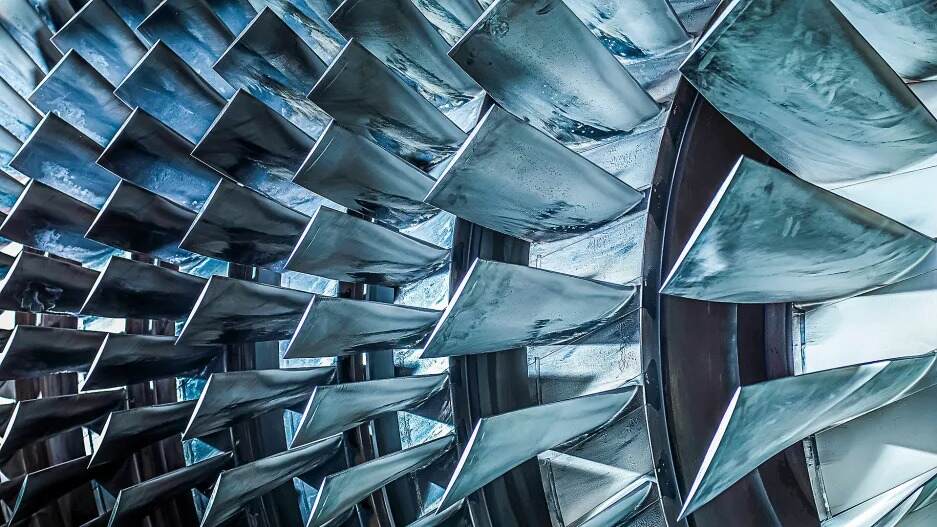- | 8:00 am
66% more energy? This new turbine could turn old power plants into clean(er) machines
Its inventors believe the system can have a tremendous impact on efforts to decarbonize the energy sector.

A team of American scientists has developed a system for generating electricity that they say is a “game changer.” It’s a device that has the potential to radically increase the electrical output of any thermal power plant, be it fossil fuel, solar thermal, or nuclear.
And while the system is still in the research phase, the team has demonstrated that it works when wired into the real-world grid.
Designed by Logan Rapp and Darryn Fleming at the Sandia National Laboratories in Albuquerque, the new system is the implementation of an old idea from the ’60s, an alternative turbine to the traditional steam turbines found inside thermal power plants.
“We believe this system can have a tremendous impact in our efforts to decarbonize the energy sector,” Rapp and Fleming told me over email.
Theoretically, power plants retrofitted with this new turbine could produce 66% more energy. Given that 80% of power plants in the U.S. alone may be candidates for the upgrade, the benefits to power outputs and CO2 emissions could be dramatic.
HOW IT WORKS
It doesn’t matter if they use gas, coal, nuclear reactors, or solar power: All thermal power plants use steam turbines to transform heat into electricity. Basically, these turbines are big rotors full of blades that rest in giant ball bearings in a huge metal case. They use water that gets extremely hot by whatever heat source the plant uses. The water then turns into high-pressure steam, which pushes the rotor. That rotor, in turn, moves the shaft that powers the actual electric generator.
This new system swaps out the water inside a turbine for a form of CO2. (Technically speaking, the process runs on what’s called an sCO2 Brayton cycle.) The cycle itself is not new: First patented by American mechanical engineer and inventor George Brayton in 1872, the cycle is used in modern gas turbine and air-breathing jet engines. What is new, however, is how the team at Sandia implemented the usage of what’s called “supercritical” CO2.
“The idea for using CO2 as the working fluid in a Brayton cycle is quite old, I believe the 1960s,” Rapp tells me. But it wasn’t possible back then because the technology wasn’t there yet.
An sCO2 Brayton cycle uses supercritical carbon dioxide to spin a turbine, a compound that is under such high pressure and heat that it behaves both as a liquid and a gas. Because the cycle is closed, the supercritical CO2 never escapes into the atmosphere, and is instead kept in an infinite loop in which it is cooled and heated.
This is the same principle that powers traditional steam turbines (known as Rankine cycles), but unlike those the sCO2 Brayton cycle has a much higher heat-to-electricity conversion efficiency, meaning it can put out more power from the same amount of source material: “Traditional steam Rankine cycles can achieve thermal efficiencies of approximately 33%,” Rapp says. “The sCO2 Brayton cycle has potential to achieve 50% thermal efficiency.”
In their test, the team at Sandia National Labs heated supercritical CO2 to 315 degrees Celsius (599 degrees Fahrenheit) using a heat exchanger. The sCO2 is injected into the turbine, driving a shaft that spins a coiled copper wire that interacts with the magnets of the generator to produce electricity. As it leaves the turbine, the sCO2 is cooled in a heat-recovery unit. From there, it passes to a compressor that raises its pressure again before it enters a device called a recuperator, which reheats the sCO2 with the excess thermal energy collected in the previous step.
Once heated, the sCO2 reenters the main heater to start the cycle again. All of this is controlled by electronic circuits that moderate the flow intelligently so that everything runs uninterrupted.
According to Fleming, in this test 10 kilowatts were produced and successfully injected into the Sandia-Kirkland grid for 50 minutes without interruption using commercially available electronics—which is a notable step forward.
A NEW HOPE
With the proof of concept working, the experimental program has started collaborating with the larger power sector.
“There are many companies working on this technology and there are some exciting developments in concentrated solar power and waste heat recovery that look like they might be the first commercial application of the sCO2 Brayton cycle,” Rapp and Fleming tell me.
Now they want to collect more operational data on how best to control the system—and also prove the theoretical efficiencies are experimentally achievable. “This will increase confidence in the technology and hopefully help to speed its adoption,” they say.
If it all works as expected, the ultimate goal is to retrofit today’s power plants with these more efficient turbines. But naturally, the team needs to prove the system’s feasibility, scale it to higher power levels required for large-scale operations, and sell it to a sector that can be risk-averse.
“There are demonstrations under construction right now, and interest from the broader industry is definitely growing,” Rapp says. “I’m hopeful these first systems will be operating in the next three to five years.”





































